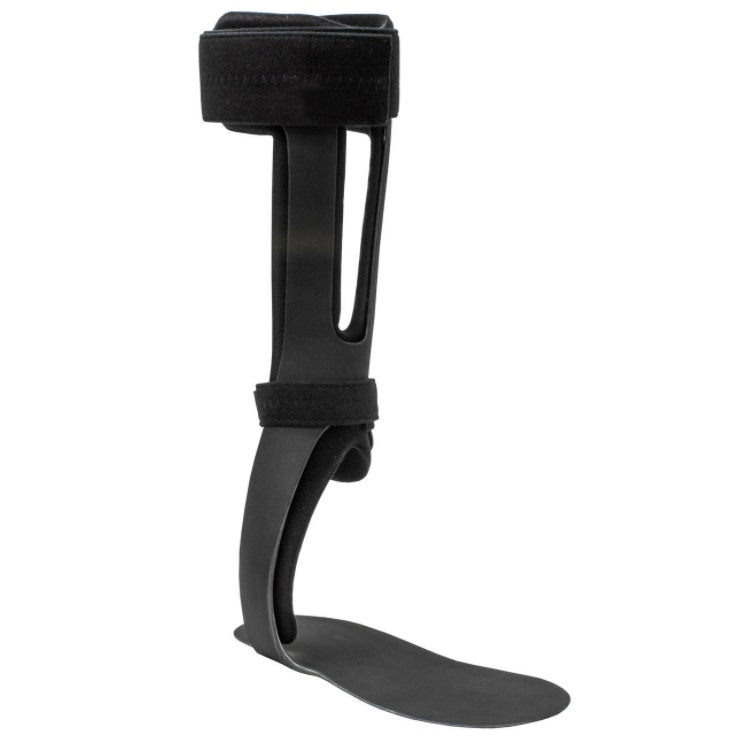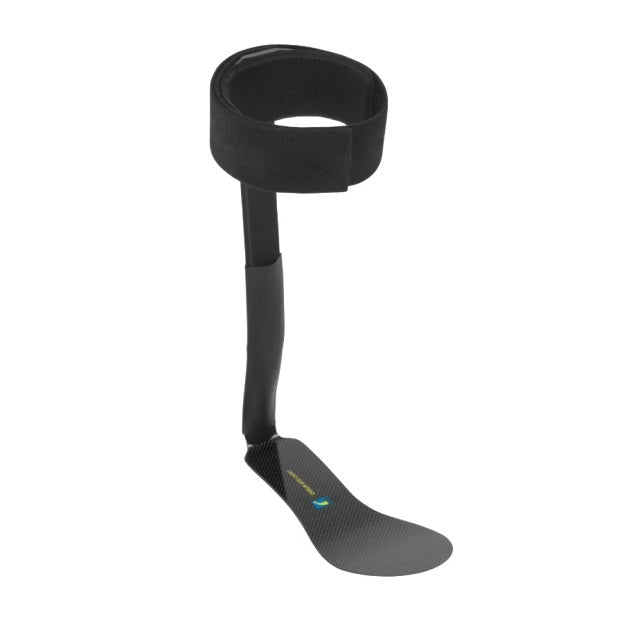Össur Carbon Fiber AFO Fit Guide (AFO Light & AFO Dynamic)
Reduce rubbing, pressure points, and shoe-fit frustration with simple setup steps—plus when a professional trim is the right move.
Quick Decision Tree: Pick a Model + Avoid Returns
This is general guidance to help with comfort and shoe fit. Your clinician should confirm the best brace for your specific condition and gait needs.
Step 1 — Pick the model
- Want the lightest / lowest-profile feel? → Start with Össur AFO Light
- Want a more “dynamic” feel / energy-return style? → Start with Össur AFO Dynamic (Flex-Foot)
Step 2 — Your shoes decide “success”
- If your main shoes have removable insoles + depth → you’re in great shape.
- If your main shoes are narrow / slip-on / no removable insole → expect shoe-fit issues (this is a top cause of returns).
- When in doubt: choose an AFO-friendly shoe before deciding it “doesn’t fit.”
Step 3 — Between sizes / footplate feels bulky?
- Try the shoe setup first (remove insole + use thin comfort insole above AFO).
- If you’re on the low end of a size range, the footplate can feel long in certain shoes.
- Best shoe fit: a prosthetics & orthotics clinic can trim/shape the footplate for your specific shoe.
Before You Buy: Measure & Shoe Check (Biggest Return Reducer)
1) Measure correctly
- Shoe size: use your usual athletic shoe size (or the shoe you plan to wear most).
- Calf height / brace height: measure the height needed at the thickest part of your calf (follow the product sizing chart on the product page).
These braces are sold in size ranges. If you’re between sizes or picky about shoe fit, plan for a “shoe test” or professional trim.
2) Quick shoe checklist
- Removable insole (essential)
- Deep toe box + enough volume
- Firm heel counter (stable back of shoe)
- Adjustable closure (laces/Velcro)
- Avoid narrow slip-ons and high heels
3) 10-minute “fit test” plan (when your brace arrives)
- Fit the brace into your best “AFO-friendly” shoe (see shoe rules below).
- Walk indoors for 5–10 minutes.
- Remove and check skin. Mild pinkness that fades can happen early. Stop for sharp pain, blisters, numbness/tingling, or redness that persists.
Quick Fix: Stop the “hard plate” feel
- Remove the shoe’s insole to create space.
- Place the AFO on the shoe’s midsole (inside the shoe).
- Add the insole back or place a thin comfort insole above the AFO so your foot rests on the insert—not directly on carbon/metal.
This simple change fixes most underfoot discomfort and improves overall “shoe feel.”
Dial in Fit & Position
- Snug, not tight: You should slide one finger between brace and leg at mid-calf. Pain, tingling, or numbness = too tight.
- Heel fully seated: Center the brace and make sure your heel sits all the way down in the shoe (no heel lift).
- Strut comfort check (important): The strut should feel supportive, not like it’s jamming behind the knee. If it feels too tall, a clinician can confirm sizing and discuss adjustment options.
- Recheck after changes: Swelling, sock thickness, weight change, or new shoes can alter fit—adjust or see a clinician.
Size Ranges & When to Trim (Pro Tip)
Many AFOs are sold in size ranges (S/M/L/XL). If you’re near the low end of a size range, the footplate can feel long/bulky and may not fit your favorite shoes well.
- Option 1: Choose the next smaller size range if it still meets your support needs.
- Option 2: Use an AFO-friendly shoe (more depth/volume) and remove the insole.
- Option 3 (best shoe fit): Have a prosthetics & orthotics clinic trim/shape the footplate for your shoe.
Socks, Liners & Padding
- Use thin, seamless, moisture-wicking socks (avoid cotton when possible), smoothed with no wrinkles.
- Interface liners reduce friction and wick sweat for longer wear.
- Spot-pad pressure areas with thin foam/gel; start minimal to avoid new hot spots.
- Don’t stack padding to force-fit a tight brace—extra thickness often makes pressure worse.
Shoes That Work with Carbon AFOs
- Removable insoles (essential) + deep toe box + firm heel counter.
- Adjustable closures (laces/straps) to fine-tune volume.
- Many users do better with slightly larger or wider shoes once the AFO is inside.
- Avoid narrow slip-ons, minimal shoes, and high heels.
Professional Trimming & Customization (When Fit Isn’t Perfect)
Carbon fiber AFOs sometimes require shoe-specific shaping. If the footplate runs long, rubs the toe box, or feels unstable in your shoe, a prosthetics & orthotics clinic can evaluate and custom-adjust for comfort.
Common “needs a trim” signs
- Toe box rub, shoe won’t close, or brace pushes your foot off-center.
- Footplate feels too long or catches when walking.
- Pressure spots that don’t improve after insole + sock + minor padding changes.
Break-In, Heat & Moisture
- Wash/dry skin before wear; consider antiperspirant per provider advice.
- Air the brace during the day if possible; remove at night.
- Clean with mild soap/water; dry fully to prevent skin issues.
- Break-in: start 1–2 hours/day, add time gradually; many users adjust in 2–4 weeks.
Common Problems & Fixes
Problem: The AFO feels hard under my foot
Use the Quick Fix: remove the shoe insole, place AFO on midsole, then add the insole (or a thin comfort insole) above the AFO.
Problem: My shoe won’t close / feels too tight
Switch to AFO-friendly shoes (removable insole, deep toe box, firm heel counter). Remove insole, loosen closures, and consider wider/deeper shoes if needed.
Problem: I have rubbing or a hot spot
Check socks (thin, seamless, no wrinkles). Add minimal spot-padding. If redness persists or you get blisters/numbness/tingling, stop and contact a clinician.
Fit Videos & Official Guides
Video: Össur AFO Dynamic overview / use
Video: AFO fitting considerations (general)
Maintenance & Skin Care
- Inspect edges/straps for wear; replace worn parts promptly.
- Moisturize skin at night (not right before wear) to avoid slippage.
- Stop use and contact a clinician for persistent redness, blisters, numbness/tingling, or swelling.
Frequently Asked Questions
Which Össur AFO should I choose: AFO Light or AFO Dynamic?
In general, AFO Light is a lightweight, low-profile option often chosen for mild–moderate foot drop, while AFO Dynamic is commonly chosen when a more “dynamic” feel and energy return is desired. Your clinician should confirm the best option for your needs.
What if I’m between sizes or the brace feels bulky in my shoe?
These braces are sold in size ranges (S/M/L/XL). Try the shoe setup first (remove insole + thin comfort insole above the AFO). If you’re on the low end of a size range, the footplate can feel long/bulky in certain shoes—professional trimming/shaping by a clinic is often the best shoe-fit solution.
How do I stop the AFO from feeling hard under my foot?
Remove the shoe’s insole, place the AFO inside on the midsole, then add the insole back (or a thin comfort insert) above the AFO. Your foot rests on the insert instead of carbon/metal.
Do I need bigger shoes for an AFO?
Often yes. Look for removable insoles, a deep toe box, a firm heel counter, and adjustable closures. Some users prefer a slightly larger or wider shoe once the AFO is inside.
Can the carbon footplate be trimmed?
In many cases, yes—but carbon fiber trimming should be done by a prosthetics & orthotics professional. Modified items typically can’t be returned as new.


